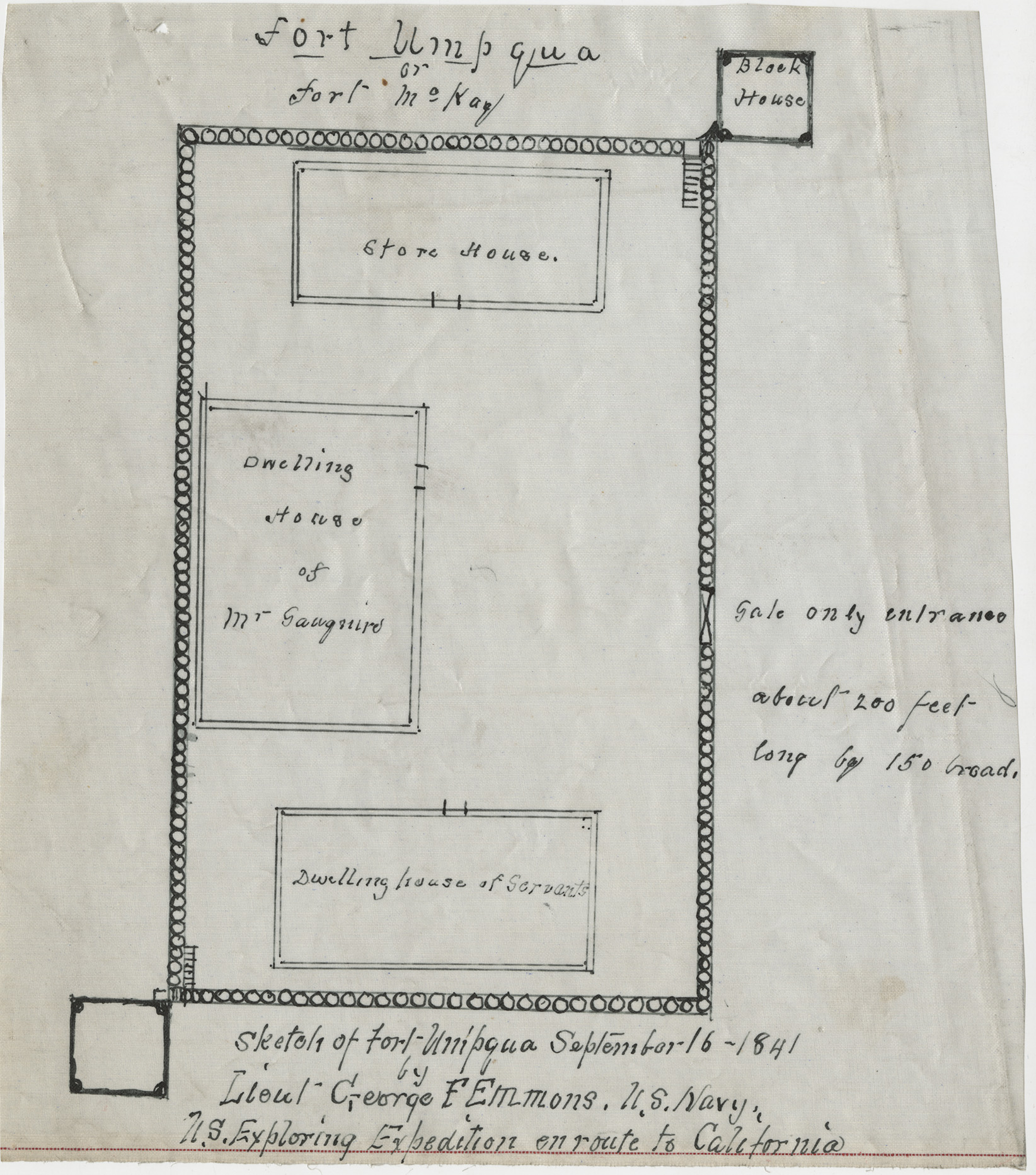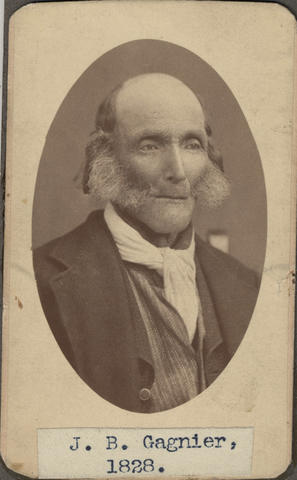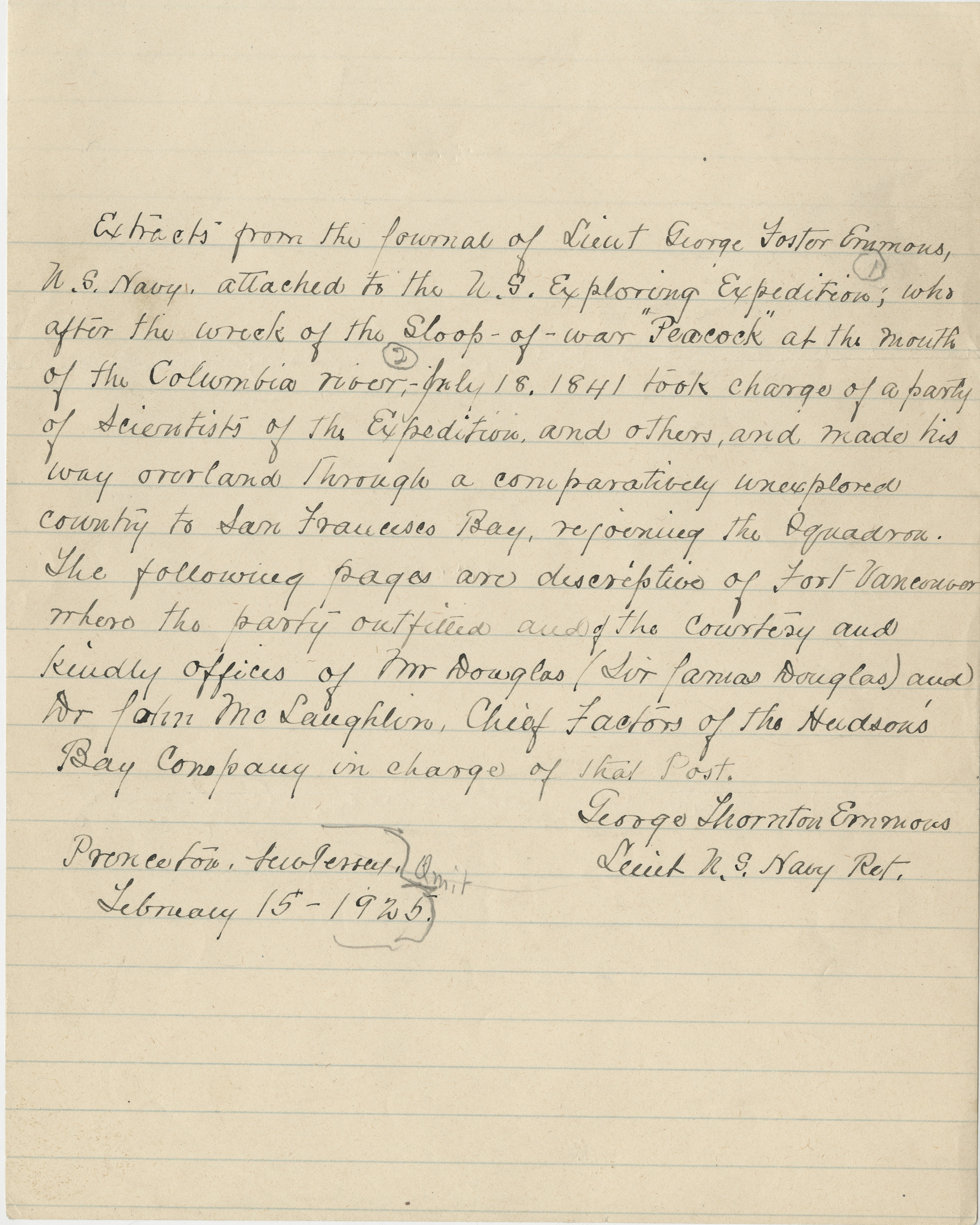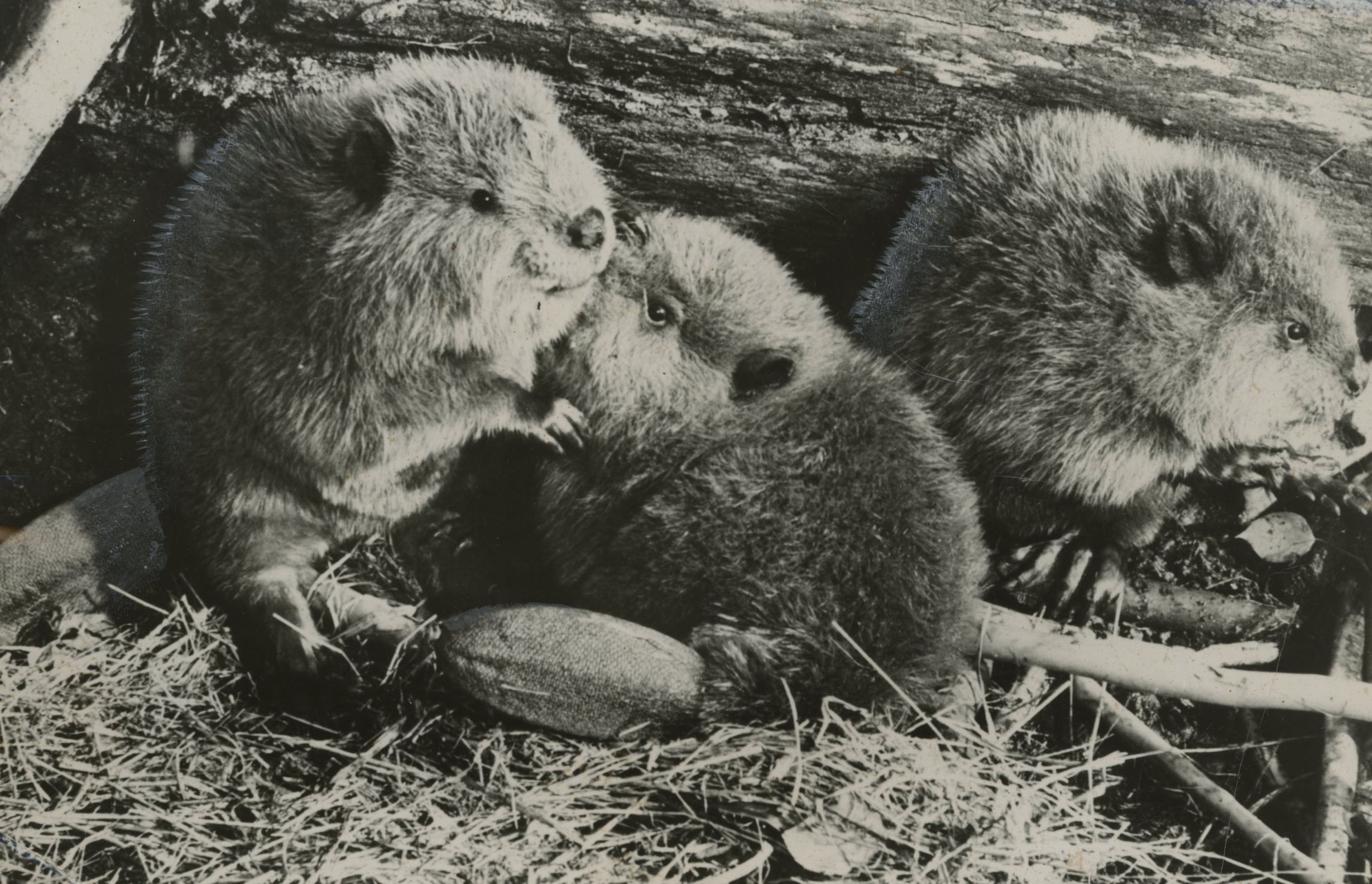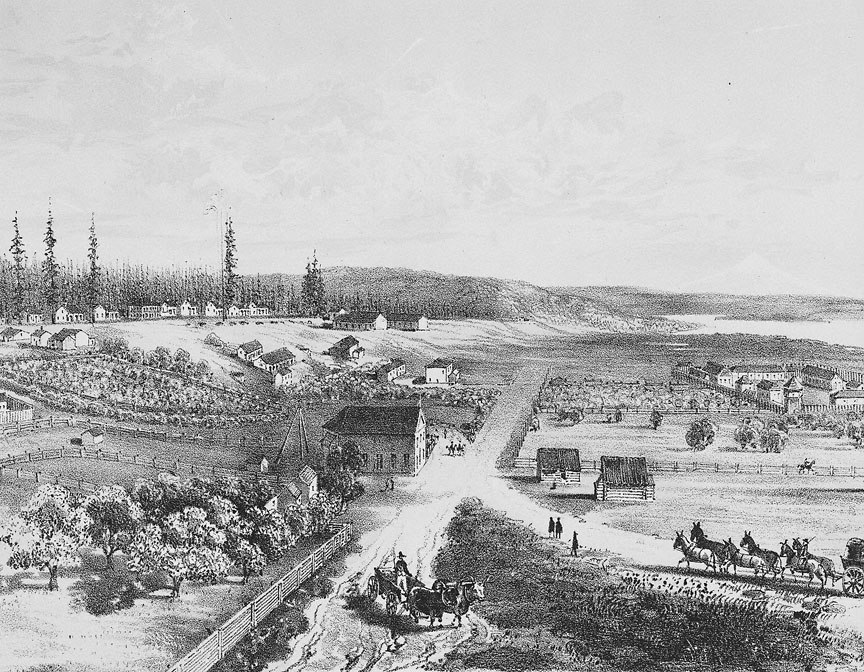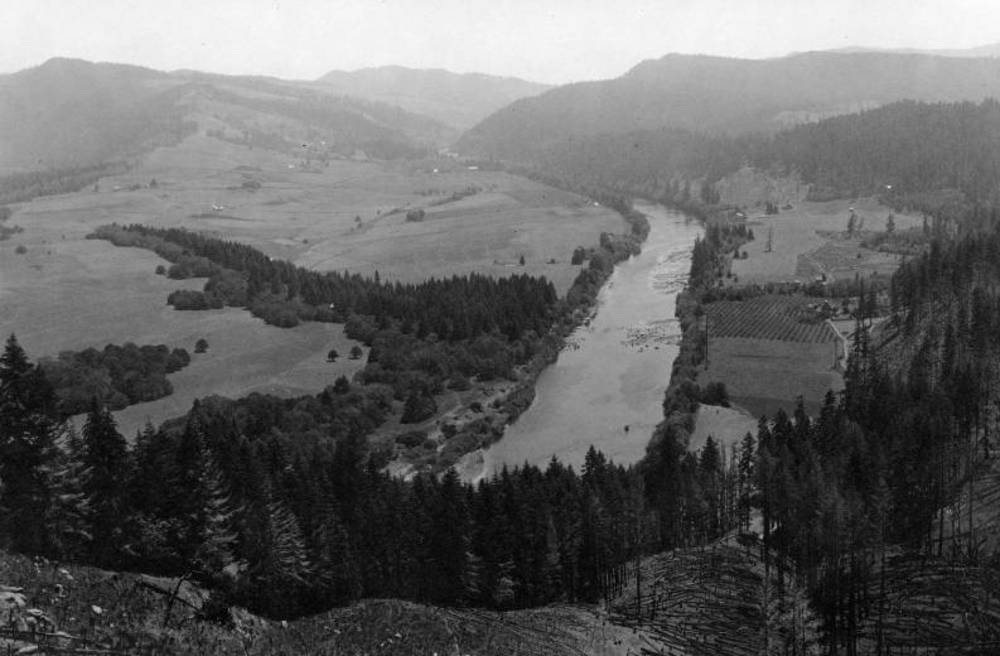Fort Umpqua was a small but important post in the Hudson’s Bay Company’s fur-trade empire in the Oregon Country. The farthest south of the company’s posts, the fort was located on the Umpqua River in present-day Douglas County. Operating between 1836 and the early 1850s, it was crucial to the supply of the HBC’s regular Southern party, which annually trapped for beaver southward from the Umpqua River and into central California. During the 1840s, Fort Umpqua served as a waystop for travelers on what became the main trail between California and Oregon. It was the first non-Native year-round settlement in southern Oregon.
Thirty-four-year-old Jean Baptiste Gagnier, a French Canadian, located Fort Umpqua on a broad, flat terrace at a sweeping westward bend of the Umpqua River. The land was in territory used mainly by the Yoncalla band of Kalapuya, with some Lower Umpqua people from downstream occasionally visiting. Located on the west bank of the river, it was a short distance upstream from the mouth of Elk River (the present town of Elkton).
In 1841, U.S. Navy Lt. George Emmons drew a plan of Fort Umpqua, which he described as a “picketed enclosure something like [Fort] Vancouver.” The 200-by-150-foot stockade was built of twelve-foot-high log pickets, and elevated bastions with gun ports “commanding all sides of the fort” were located on two opposite corners of the enclosure. There was a storehouse for furs and supplies, a house for the post’s master, and a dwelling for the fort’s few employees. It appears that the fort’s single gate faced east, toward the river.
HBC’s Fort Umpqua is not to be confused with an earlier fur-trading camp on the Umpqua River called the Old Establishment or McKay’s Old Fort. Located on the river, either at the mouth of the Calapooya River or about six miles downstream from that river’s mouth, McKay’s Old Fort may have predated Fort Umpqua by as many as sixteen years. Thought to have been established by either Thomas McKay or Jean Baptiste Desportes (also known as McKay), both HBC men, the Old Establishment may have been little more than a few log huts used to store furs; it saw seasonal use into the 1830s. Yet another Fort Umpqua was built in 1856 by the U.S. Army near the mouth of the Umpqua River, at the southern end of the Coast Indian Reservation; it was abandoned during the Civil War.
Jean Baptiste Gagnier served as Fort Umpqua’s post master for much of its existence. Ordered to make the place as self-sufficient as possible, he raised wheat and corn, grew vegetables such as melons, onions, and potatoes, and planted an apple orchard—the earliest such endeavors in Oregon south of the central Willamette Valley. In 1841, U.S. Navy Lt. Henry Emmons estimated that Fort Umpqua had 80 acres of cropland and over 2,000 feet of rail fence.
Fenced pasture of native grass supported the horse herd that supplied fresh mounts for the annual Southern-party brigades, led by HBC fur trader Michel Laframboise and others. Men at the post also raised cattle and hogs. Like most HBC posts in the Oregon Country, the fort housed people from a variety of backgrounds, including French Canadians, Métis, Hawaiians, local Natives, Iroquois, and Scots. The number of men working at Fort Umpqua rarely exceeded a dozen.
For the most part, the fort’s relations with Natives were peaceful and regularly involved ongoing trade. An exception occurred in 1838, when HBC Factor James Douglas wrote that some Lower Umpqua began to “menace the post…with destruction.” Douglas, evidently concluding that Gagnier was without sufficient martial experience, sent “Mr. Thomas McKay and six good men” from Fort Vancouver to “tranquilize the Natives.” McKay had been a familiar figure in the Umpqua Country since the 1820s, and he apparently accomplished his task without violence. The following year, Douglas wrote that the Natives at Fort Umpqua were “quiet and well disposed.” Another period of tension occurred in 1841, when Native deaths from smallpox (likely brought to the area by white travelers) caused the Natives to threaten the post’s employees.
By the early 1840s, the watersheds of the Umpqua, Rogue, Klamath, and Sacramento Rivers had become trapped out, and annual forays of the Southern party soon ended. Fort Umpqua remained as a minor Company outpost that conducted a declining trade with local Indians. In 1850, the captain of the American trading vessel Samuel Roberts reported that “there was formerly a brisk business carried on here…but at present it doesn’t amount to much.”
Most of the fort burned in November 1851, but a few HBC men remained there until 1853. The Company then leased the land to American settlers, who raised cattle on the broad river terrace. After sale of the land, the Henry Beckley family owned and farmed the fort site for many years. Although the approximate location of the fort is known, it has not been verified by archaeological investigation and the area is not open to the public.
In 2009, the Elkton Community Education Center completed a replica of Fort Umpqua on the east bank of the Umpqua River on Highway 38. Open to the public, it features living history exhibits. Elkton has celebrated the annual Fort Umpqua Days for more than a decade.
-
![]()
Sketch of Fort Umpqua by Lt. Emmons, 1841.
Courtesy Oregon Hist. Soc. Research Lib., mss171 19WGdJd
-
![]()
Jean Baptiste Gagnier.
Courtesy Oregon Hist. Soc. Research Lib., ba000462
-
![Read longer version by clicking on "Documents" tab. Diary was hand-copied from the original in 1925.]()
Introductory page of excerpts from Lt. George Emmons's diary, 1841.
Read longer version by clicking on "Documents" tab. Diary was hand-copied from the original in 1925. Courtesy Oregon Hist. Soc. Research Lib., Mss171
Related Entries
-
![Beaver]()
Beaver
The American Beaver (Castor canadensis) is often called “nature’s en…
-
![Fur Trade in Oregon Country]()
Fur Trade in Oregon Country
The fur trade was the earliest and longest-enduring economic enterprise…
-
![Hudson's Bay Company]()
Hudson's Bay Company
Although a late arrival to the Oregon Country fur trade, for nearly two…
-
![Umpqua River]()
Umpqua River
The Umpqua River, approximately 111 miles long, is a principal river of…
Related Historical Records
Map This on the Oregon History WayFinder
The Oregon History Wayfinder is an interactive map that identifies significant places, people, and events in Oregon history.
Further Reading
Beckham, Stephen Dow. Land of the Umpqua: A History of Douglas County, Oregon. Douglas County Commissioners, 1986.
Schlesser, Norman Dennis. Bastion of Empire: The Hudson's Bay Company's Fort Umpqua. Oakland, Calif.: Oakland Printing Company, 1973.

